Surfing in Oahu: A Complete Guide for Enthusiasts
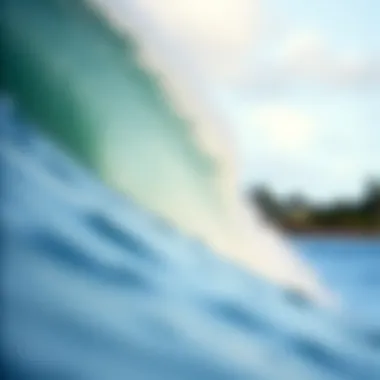
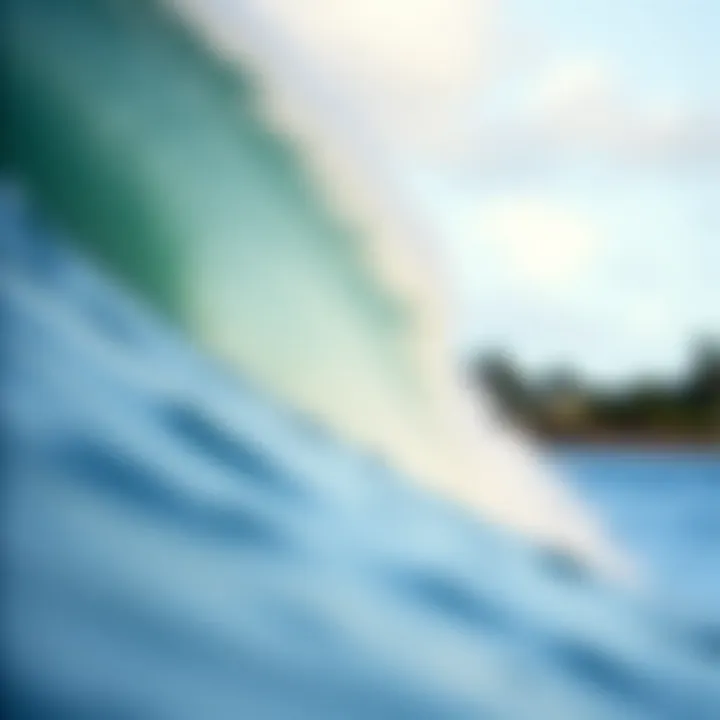
Intro
Surfing in Oahu, Hawaii, is not just about riding waves; it represents a lifestyle steeped in culture and tradition. From the moment you step onto the sun-kissed sands of Waikiki or the renowned North Shore, it's clear that the spirit of the ocean flows through every soul you encounter. Whether you are a novice surfer learning to catch your first wave or a seasoned pro fine-tuning your skills at Sunset Beach, understanding the myriad factors affecting this beloved sport is essential.
As you navigate through this guide, you will uncover the various surf breaks that define each region of the island, appreciate the cultural nuances of the surfing community, and explore the gear that can make or break your experience on the water. It is not merely about having the latest surfboard; it's about understanding the ocean and respecting its power. So grab your sunscreen and let's paddle out into the exhilarating world of surfing in Oahu.
Gear and Equipment
When preparing for the waves, having the right equipment can elevate your surfing experience. The choices about gear are vast and varied; however, understanding the fundamentals can help ensure that you feel confident and comfortable on the water.
Latest Surfboard Technologies
The technology behind surfboards has come a long way, especially in the last decade. Specialized materials like epoxy resin and foam contribute to lighter, sturdier boards that can handle more aggressive waves. Consider the following types of surfboards that cater to different skill levels and wave conditions:
- Shortboards: Popular among advanced surfers, these boards are designed for agility and speed, typically measuring between 5’5" and 6’6". They’re ideal for catching fast, powerful waves.
- Funboards: A blend between shortboards and longboards, ideal for beginners looking for a balance of stability and maneuverability, usually ranging from 7’0" to 8’0".
- Longboards: Perfect for riders who appreciate a more leisurely pace on the waves, these boards measure 9’0" and above, providing excellent stability for beginners.
These technological innovations not only improve performance but also provide overlap across various surfing disciplines, allowing enthusiasts to explore diverse wave types.
Essential Accessories for Every Surfer
Beyond the board itself, there are several accessories every surfer should keep in their bag:
- Wetsuits: Depending on the time of year, a wetsuit may be necessary to keep you warm during your sessions. In Oahu, thinner suits are generally preferred for summer.
- Leashes: Always invest in a good leash, as it keeps your board attached to you, preventing potentially dangerous situations.
- Wax: Ensuring grip on your board requires regular waxing; the right wax can make a significant difference, especially in warm water.
While these might seem like small details, they can substantially influence your overall surfing experience.
Surf Techniques and Skills
Surfing is a skill that continuously evolves with practice and dedication. Whether you're just starting or looking to refine your techniques, understanding the fundamentals can help in navigating the waves more effectively.
Beginner Surfing Techniques
For beginners, the key is to develop a strong foundation. Here are some essential techniques to get you started:
- Paddling: Effective paddling is crucial for catching waves. Use long, deep strokes.
- Pop-Ups: Mastering the pop-up technique—going from lying on the board to standing— is vital. Practice in shallow waters to build confidence.
- Positioning: Learn where to sit on your board to maintain balance and ready yourself for incoming waves.
As you practice these techniques, remember to remain patient and enjoy the learning process.
Advanced Maneuvers for Experienced Surfers
Once you’re comfortable, there’s a world of techniques to explore that can enhance your surfing experience:
- Cutbacks: This maneuver helps you redirect your momentum back towards the wave before it closes out.
- Aerials: For those looking to add flair to their repertoire, aerials involve leaping off the wave and landing back on the water with control, a skill best reserved for more experienced surfers.
- Carves: Perfect your carves by applying pressure on the rail of your board, enabling smoother turns.
Mastering these techniques takes time, but each triumph in the water reaffirms the connection you cultivate with the ocean.
Remember, the ocean is a dance that demands respect, patience, and practice.
With every wave you ride, you’ll find a unique experience that combines thrill, community, and a connection to the breathtaking beauty of Oahu.
For further reading about surfing culture and history in Hawaii, check out Wikipedia or Britannica. Keep practicing and enjoy the journey!
Prelude to Surfing in Oahu
Oahu, often referred to as the heart of Hawaiian surfing, serves as a rich canvas for both seasoned surfers and enthusiastic newcomers. This island is much more than just a beautiful landscape; it is a cultural hub where the ocean bids an open invitation to those who wish to ride its waves. The importance of this topic cannot be understated, as understanding the nuances of surfing in Oahu lays the groundwork for a fulfilling experience on the water.
First and foremost, surfing in Oahu is steeped in history. The ancient Hawaiians embraced surfing not just as a sport, but as a means of connecting with their environment and community. This background enriches the experience, making each ride not just a physical endeavor, but a homage to a time-honored tradition. By learning about this cultural backdrop, surfers gain a deeper appreciation for their pursuit, fostering respect for both the ocean and the local surf community.
Among the many benefits of surfing here, the variety of available waves stands out. With coastlines that cater to all levels, Oahu features everything from gentle swells in Waikiki Beach, perfect for beginners, to the formidable waves at the Banzai Pipeline, a challenge even for the most seasoned of surfers. This diversity means that regardless of skill level, there is always an opportunity to learn and grow.
Moreover, Oahu is not merely a surfing destination; it is a lifestyle. The island's vibrant beach culture encourages a sense of camaraderie. Surfers often exchange tips and experiences, building a network that provides both safety and support. Engaging with this community can enhance the overall surfing experience, turning a solitary pursuit into a shared adventure.
In terms of practical considerations, understanding the geographical aspects of surfing in Oahu—like the wind directions, tidal patterns, and seasonal changes—can significantly impact one’s surfing experience. Each surf spot on the island has its quirks, which can dictate optimal surfing conditions. Being aware of these factors ensures that you maximize your time on the water.
To sum it up, surfing in Oahu is not just about the action of riding waves. It encompasses a rich cultural heritage, a supportive local community, and nuanced knowledge of the ocean's behavior. By diving into these elements, surfers set themselves up for memorable experiences.
"To surf in Oahu is to ride not just on water, but on the threads of tradition woven into the very fabric of Hawaii."
Embracing the spirit of Oahu's surf culture can lead to a richer, more immersive experience, making every wave ridden more profound than the last.
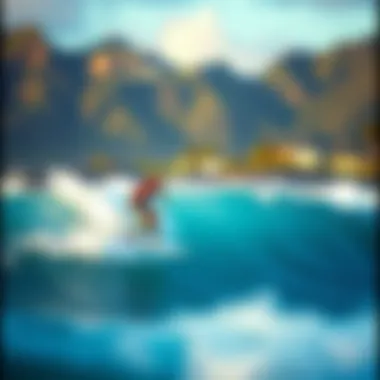
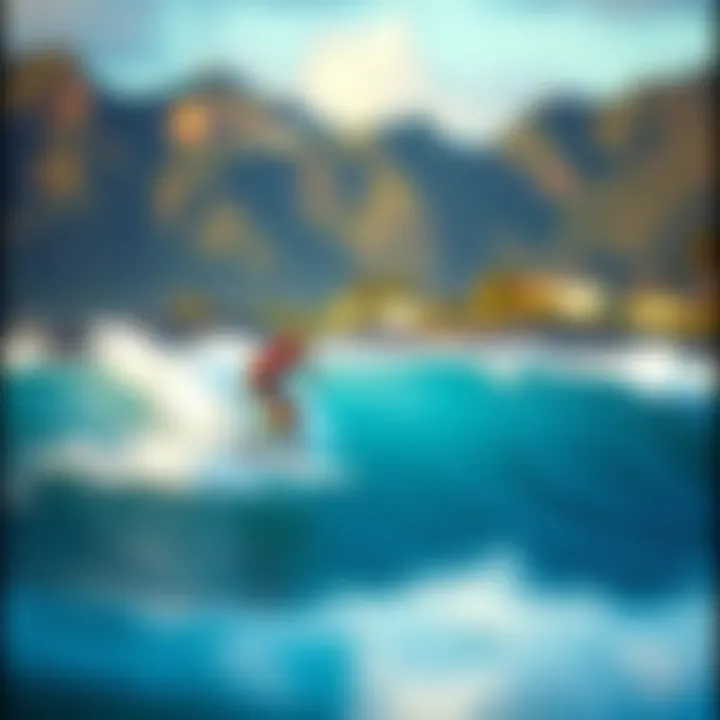
Geographical Significance of Oahu
Understanding the geographical significance of Oahu provides crucial insights into its role as a premier surfing destination. Oahu's unique coastline, varied topography, and oceanographic conditions come together to create a tapestry of surfing experiences that attract riders from all around the globe. This island isn't just about beaches; it’s a land of contrasts with mountains, valleys, and shorelines that all influence the surfing conditions.
Overview of Oahu's Coastline
Oahu’s coastline stretches approximately 112 miles and is diverse in its offerings. The island has famous beaches like Waikiki, known for its inviting waters, and the North Shore, renowned for its enormous winter swells. This variety in the coastline means surfers can find suitable waves for every skill level.
- The North Shore: Its long sandy beaches lined with powerful reefs create the perfect storm for world-class waves. Surf spots here, such as Waimea Bay and Sunset Beach, are legendary and often host major competitions.
- Waikiki Beach: Unlike the North Shore's wild surf, Waikiki offers gentler waves ideal for beginners and longboarders. The picturesque surroundings and historical significance also make it a must-visit spot.
- Windward Coast: The less-traveled areas like Kailua and Lanikai may not offer the popularity of the North Shore but hide gems that are worth exploring, providing simpler, less crowded waves.
Consider the differences along Oahu’s coast; abundant reefs, diminishing beach breaks, and varying currents. These all shape the surf and make each area distinct in both experience and challenge, giving surfers a rich landscape to explore.
Topographic Features Influencing Waves
Oahu's topography is a significant player in wave formation. The island is characterized by a volcanic origin, where the remnants of ancient volcanoes shape island's land. This geological history has a direct hand in producing the waves that surfers chase.
- Underwater Topography: The placement of reefs and ledges beneath the ocean surface plays a pivotal role in how waves form and break. Areas like the famous Banzai Pipeline are shaped by unique underwater formations that create the hollow waves surfers crave.
- Wind Patterns: Coastal winds change patterns based on geography, influencing the size and direction of the waves. Understanding these can not only improve a surfer's technique but also help in selecting the right time to hit the water.
- Currents and Swells: The interaction of ocean currents around Oahu can either enhance or diminish wave quality. Strong currents can provide exciting challenges, while milder conditions may foster a more relaxing ride.
"Oahu's complex geography is not merely an element; it's a part of the surfing narrative, shaping not just the waves, but the entire surf culture surrounding it."
This interplay between topography and surfing conditions means that surfers must not only be physically prepared but also intuitive to the ocean’s rhythms. Being aware of these geographical nuances equips surfers with knowledge that enhances their riding experience and safety.
Key Surf Breaks in Oahu
Understanding the key surf breaks in Oahu is like cracking the code to the island's surfer culture. Each wave tells a story, carrying its own spirit, challenges, and rewards. This section aims to illuminate why these surf spots stand out, examining their unique characteristics, what surfers can expect from each break, and the community surrounding them. Whether you're a newbie seeking gentle waves or a seasoned rider chasing that perfect curl, knowing the right breaks makes all the difference. Let's dive into the specifics of what makes each spot special and how they contribute to the rich tapestry of surfing in Oahu.
Waikiki Beach: A Surfer's Paradise
Waikiki Beach is perhaps the most famous surf spot in Oahu. It’s not just about the waves here; it’s about the whole experience. The gentle, rolling swells make it ideal for beginners looking to catch their first wave, while also catering to more seasoned surfers who appreciate its vibe. The long, sandy beach stretches out with iconic views of Diamond Head, making it an aesthetically pleasing location as well.
The area is also dotted with surf schools, which means that amateurs can get lessons from experienced instructors. The lively atmosphere means you'll often see a bustling crowd, which for many, adds to the thrill of surfing. Expect shared waves and a chance to meet fellow surf enthusiasts from all over the globe. The local surf community is generally welcoming, fostering an environment where everyone can enjoy their ride.
Banzai Pipeline: The Adventurer's Challenge
For advanced surfers, Banzai Pipeline is the crown jewel of Oahu’s surf spots. Known simply as "the Pipe," it is famous for producing some of the most powerful waves in the world, breaking over a shallow reef. Surfers flock here for the thrill of riding these iconic barrels that have launched the careers of many pro surfers. But with great power comes great responsibility; the waves here can be dangerous, making this spot suitable for only the most skilled riders.
The Pipeline isn’t just a wave; it's a rite of passage for many. You'll often see competitions held here, showcasing the world's best. Just remember to respect the locals and the ocean. Those who are not yet ready for such challenging conditions should keep their distance and choose more suitable spots like Waikiki.
Sunset Beach: A Global Stage
Another surf haven, Sunset Beach is renowned for its significant waves, especially during the winter season. It's a must-visit for anyone serious about surfing. The beach hosts the Vans Triple Crown of Surfing, attracting top surfers from around the globe. This spot offers faster waves that can lead to thrilling ride, especially when the surf is up.
Yet, what draws surfers in isn’t merely competition; it’s the community and the spectacle. The beach is often lined with spectators who come to watch the action unfold. It's a place where memories are made, and legends are born, reminding us why we love the unpredictable nature of the ocean.
Ala Moana Bowls: Local Favorite
Nestled near the bustling city, Ala Moana Bowls is a gem for both locals and visitors. It delivers consistent, quality surf that suits all skill levels. The waves are easier to catch than at some of the more intimidating spots, allowing surfers of various experiences to enjoy a day in the water. This makes it a great alternative to Waikiki when it gets too crowded.
The serene setting and stunning views of the Honolulu skyline only add to the appeal. With its winding left-hand waves, surf here lets you enjoy long rides while soaking in the beauty surrounding you. Plus, Ala Moana usually draws a friendly crowd, making it a perfect spot for those looking to build connections in the local surf scene.
"Surfing is not about the destination; it’s about the journey."
Understanding and exploring these surf breaks is crucial; they highlight the diverse nature of Oahu’s surf culture. Each location has its own character and challenges, catering to a wide range of preferences and skill levels. As you navigate through these spots, you’ll discover much more than just surfing; you’ll immerse yourself in the heart and soul of the island.
Surfing Seasons and Conditions
Understanding the seasons and conditions when surfing in Oahu is crucial for both novices and seasoned surfers. The island is beloved for its consistent waves, which vary significantly throughout the year. Both local surfers and transient wave chasers rely on this knowledge to maximize their time on the water. Knowing when to hit the beach can mean the difference between catching epic swells or just bobbing like a cork.
The ocean is a living entity, influenced by the winds, tides, and weather patterns. Each season brings its own character to the surf, affecting wave size, frequency, and nature. It's a dance between nature and surfer, and understanding the rhythms helps those seeking thrills and enjoyment. Let’s explore the two distinctive seasons that shape the surfing experience in Oahu.
Winter Swells: Power and Frequency
Winter is synonymous with powerful surf in Oahu. This season sees the northern hemisphere’s storms generating swells that roll into the island with remarkable speed and intensity. From November to March, the most talented surfers flock to the North Shore to challenge themselves against the infamous Banzai Pipeline and Sunset Beach.
During this period:
- Waves often reach heights of 10 to 30 feet, depending upon the storm activity.
- Conditions can vary greatly; on a good day, the surf is glassy, but it can also turn chaotic with shifting winds and currents.
- Local knowledge becomes invaluable, as seasoned surfers can navigate the intricacies that these powerful waves present.
The thrill of riding these huge waves is countered by the need for respect and caution when engaging with the ocean's might. Proper equipment, experience, and awareness of one's limits are critical.
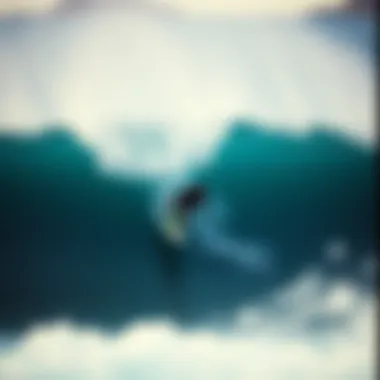
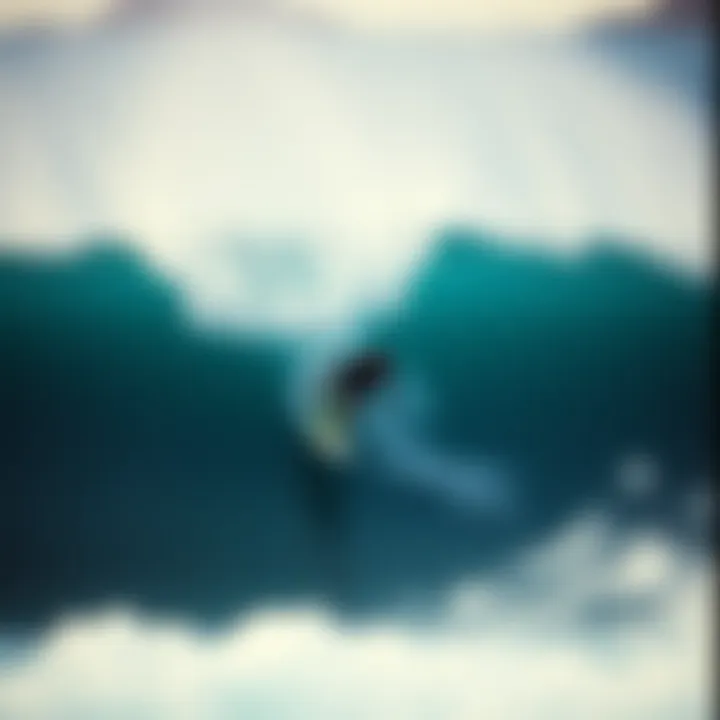
"Surfing is not just about riding waves; it's about understanding the ocean as a living part of our world."
Summer Conditions: Smaller and Mellow Waves
As summer rolls in, from April to October, the surf scene transforms. Waves mellow out significantly, creating ideal conditions for beginners and families looking to enjoy the water without the adrenaline-pumping heights. This is the time for leisure rather than just thrill-seeking.
Some characteristics of summer conditions include:
- Generally smaller waves averaging 2 to 6 feet, making them perfect for learning and honing skills.
- Sunny weather stays consistent, providing a beautiful backdrop for a day at the beach.
- Popular spots like Waikiki Beach come alive, where longboarders and novices enjoy the gentle breaks.
Typically, the summer is when surf schools thrive, offering lessons tailored to those eager to learn. The calm waters also allow surfers to experiment with new techniques without facing the dangers presented in winter swells.
In this season, surf fans also engage in local competitions, allowing them to showcase their skills in a more relaxed atmosphere compared to the winter months.
Embracing Oahu's surfing conditions through the seasons is a rite of passage for many. The cultural and historical significance attached to surfing in Hawaii, coupled with the island's geographical blessings, creates an unmatched experience that goes beyond sport. For more insights about Hawaii’s unique surfing culture, you might visit Encyclopedia Britannica.
For those seeking constant updates regarding wave conditions, surf forecasts play a significant role in planning surf trips. Resources like Surfline and local social media forums can keep surfers in the loop about the prime surfing days and safety alerts.
Cultural Context of Surfing in Oahu
Surfing in Oahu is not just a sport; it’s woven into the very fabric of Hawaiian culture and history. Understanding this cultural context is essential for anyone looking to appreciate or participate in the vibrant surfing community on the island. Surfing is more than a thrill-seeking pastime here; it embodies a deep connection with nature, tradition, and the spirit of aloha. This nuanced relationship informs every wave ridden and every beach visited, making it crucial for surfers, both local and visiting, to be aware of the cultural significance that accompanies this beloved activity.
The History of Surfing in Hawaii
The roots of surfing in Hawaii stretch back centuries, tied closely to the ancient Polynesian navigators who discovered the islands. These early voyagers showcased their skills on the waves, using surfboards made from wood or grass. Surfing was more than entertainment; it had social and spiritual dimensions. Chiefs often exhibited their prowess, and skilled surfers were held in high esteem.
The sport saw a revival in the 20th century, particularly after Duke Kahanamoku, known as the father of modern surfing, popularized it internationally. He surfed with a unique flair, capturing the imagination of audiences around the world and introducing the elegance of Hawaiian surfing to new fans. This legacy continues today as surfers on Oahu strive to honor traditions through techniques and styles passed down through generations.
Cultural Practices and Surf Etiquette
Embracing surf culture in Oahu extends beyond just riding waves. It entails respecting the ocean, fellow surfers, and the local community. Various customs are in place to maintain harmony and appreciation amongst surfers. Here are key cultural practices and etiquette norms:
- Respect the Ocean: The ocean is viewed not merely as a playground but as a living entity deserving of respect. Surfers are encouraged to partake in practices that protect the ecosystem, such as avoiding coral damage and cleaning up after themselves.
- Know the Lineup: Each surf break comes with its own dynamics and local surfers who frequent it. Respecting the lineup—understanding who has the right of way and when to drop in—is crucial to foster goodwill.
- Speak the Right Language: Locals often use Hawaiian terms, and familiarizing oneself with these adds a layer of respect and understanding. Words like "aloha" and "mahalo" embody the spirit of community and gratitude.
- Be Mindful of Local Surfers: Many breaks are beloved by locals, who consider them not just surf spots but part of their heritage. Show respect by acknowledging experienced riders and observing their practices.
"Surfing in Hawaii is about connection, respect, and understanding the spirit of the waves. It’s about being part of something bigger than oneself."
The cultural context surrounding surfing in Oahu enriches the experience for both locals and visitors. By embracing these traditions and practices, every wave tackled becomes part of a larger narrative—one that honors the history and the spirit that makes surfing in Oahu unique.
Essential Gear for Surfers in Oahu
When it comes to surfing in Oahu, having the right gear is not just about style; it’s about safety, comfort, and enhancing your overall experience in the water. Whether you're a beginner or have been riding the waves for years, understanding essential surfing equipment can greatly influence your performance and enjoyment. As the saying goes, "Failing to prepare is preparing to fail." This wisdom holds especially true for surfers navigating the diverse conditions of Oahu’s waters.
Surfboard Types and Selection
Choosing the right surfboard can be the difference between a triumphant ride and a frustrating tumble. There are various surfboard styles suited to different levels of experience, wave conditions, and personal preferences. Here’s a breakdown:
- Shortboards: Typically less than 6’6", shortboards provide agility and speed, making them favorites among experienced surfers tackling powerful waves at spots like Banzai Pipeline.
- Longboards: Ranging from 8’ to over 12’, longboards offer better stability and ease of paddling. They are perfect for beginners learning to catch waves or for those that prefer a relaxed ride at places like Waikiki Beach.
- Fish Boards: Characterized by their wider tails and shorter length, fish boards are suitable for smaller, mushy waves. They offer a unique blend of speed and maneuverability.
- Funboards: These hybrid boards typically fall between longboards and shortboards in size. They cater to a variety of conditions and are great for transitioning from beginner to intermediate.
When selecting a board, consider factors such as your skill level, the usual wave size where you will surf, and your style of riding. It's wise to test a few different boards to see what feels right. Remember, fit matters; too long or wide, and it'll be unwieldy. Too short, and it’ll lack stability.
Wetsuits vs. Boardshorts: What to Wear
The choice of whether to wear a wetsuit or boardshorts often hinges on the water temperature and your personal comfort. Oahu's waters can range from warm on the surface to surprisingly chillier depths.
- Wetsuits: Ideal for winter surfing, wetsuits help maintain body heat while providing buoyancy. They vary in thickness and style: 1mm for warmer days and thicker for lower temperatures, there is a fit for every hour surfing on the island. If you fancy a long session at popular spots like Sunset Beach, opting for a wetsuit can offer both comfort and protection against potential stings from marine life.
- Boardshorts: Perfect for the warm Hawaiian climate, boardshorts allow for freedom of movement. They come in various styles and materials, designed for both performance and comfort. If the air is warm and you’re hitting those mellow summer waves, boardshorts might just be what you need.
Choosing between the two often boils down to personal preference. Some surfers opt for a combination of both; wearing boardshorts over a wetsuit for optimal flexibility.
Safety Gear: A Necessity for All Levels
Surfing carries an inherent risk, and understanding the importance of safety gear cannot be overstated. From beginners to seasoned surfers, it’s critical to be prepared.
- Leash: A leash keeps your board tethered to you, especially if you wipe out. No one wants to play dodgeball with their board while trying to swim back to shore.
- Helmet: While not common among everyone, wearing a helmet may be advisable for those hitting reefs or larger, more powerful waves. Your noggin deserves protection.
- Rash guards: These lightweight shirts help guard against UV rays as well as rashes from your board. It's a small investment that can make your time in the water much more enjoyable.
- Surfing booties: For those days when you’re dealing with rocky bottoms or colder conditions, booties can save your feet from cuts and scrapes.
Safety must be priority. Always check conditions and be aware of your surroundings. Logic dictates that diving into surf without proper gear is like going into battle without your armor.
"The ocean is a dangerous place when you don’t respect its power." - Local Mindset
These essentials not only enhance your performance but also ensure a safer and more enjoyable experience as you carve through the waves of Oahu. Select wisely, prepare well, and let the ocean cradle you on your surfing adventure.
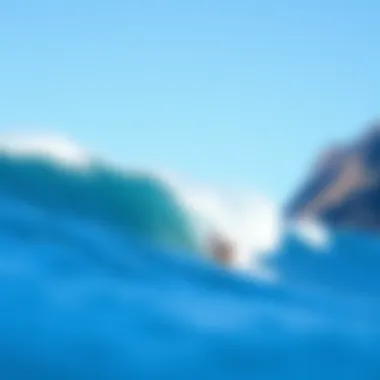
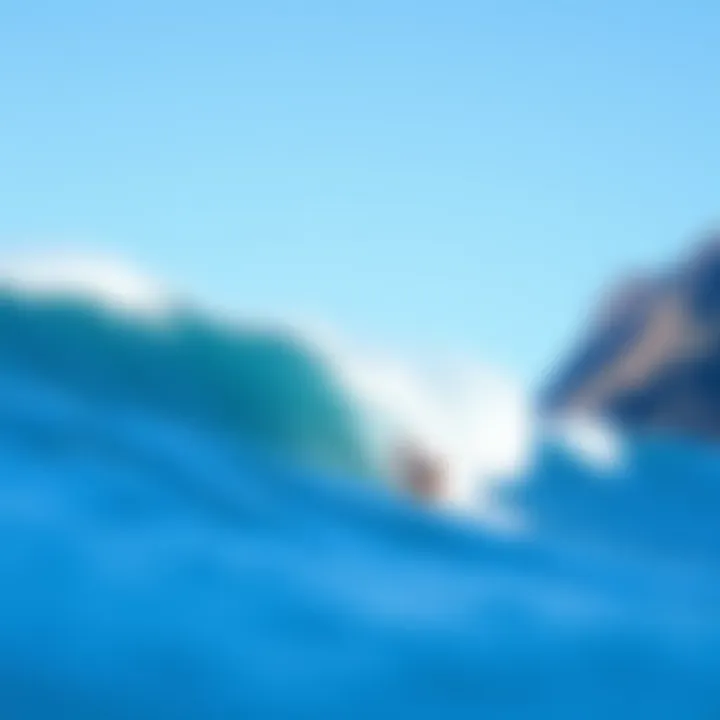
Environmental Factors Impacting Surfing
Understandably, the environment plays a critical role in shaping the surfing experience in Oahu. This section highlights the environmental dynamics affecting the waves and presents a clearer picture of both opportunities and challenges surfers may face in this surf-rich locale. Knowing the ins and outs of these factors can not only enhance a surfer's skills but also promote a more sustainable approach to riding the waves.
Coral Reefs: Ecosystem Significance
Coral reefs in Oahu are not just breathtaking views; they are the unsung creators of the island's surf breaks. These dynamic ecosystems, teeming with life, serve as natural barriers that influence wave formation and strength. They break waves, producing the perfect surfable swells, making places like the North Shore a magnet for surfers.
However, these reefs need protection. Surfers should be aware that their actions have repercussions. Poor surfing habits, pollution, and climate change threaten these coral formations, ultimately impacting the quality of waves. For instance, when reefs suffer from bleaching, the structure changes, often resulting in weaker waves that are less appealing for surfers. It's a reminder that enjoying the ocean means taking responsibility for it. Whether it’s participating in local conservation efforts or limiting reef-disturbing practices, every little bit helps.
Ocean Conditions and Safety Concerns
Oahu's ocean conditions can be as fluctuating as the waves themselves. Factors like tide patterns, wind speed, and currents all come into play, influencing when and where to surf. Understanding these dynamics is crucial for both safety and enjoyment.
- Tides: The tidal movements can significantly affect wave size and barrel shape. Some breaks are best surfed during high tide, while others peak at low tide. Knowing the tide schedule helps surfers maximize their experience.
- Wind: Offshore winds usually make for clean, well-shaped waves, while onshore winds can create choppy waters that are more challenging to navigate. A windy day sometimes calls for a change in breaks, so being adaptable is key.
- Currents: Rip currents, while scary, are a natural part of ocean life. Surfers must learn how to identify and escape them. Recognizing ocean patterns and learning how to swim parallel to the shore can be a lifesaver.
Additionally, it’s important to consider the presence of marine life. Encounters with turtles, rays, and even fish are commonplace, but it’s essential to respect their space. For surfer novices and seasoned pros alike, understanding environmental factors and safety concerns can lead not only to a better surfing experience but also to a deeper connection with the beautiful waters of Oahu.
"Respect the ocean and its life; take care of the waves, and they will take care of you."
The Local Surfing Community
Surfing in Oahu is not just about catching waves; it's inherently about community. From the sun-soaked shores of Waikiki to the adrenaline-fueled skips of the Banzai Pipeline, the local surfing community shapes the very fabric of the island’s surf culture. Understanding this community is vital for anyone hoping to ride the waves here, whether you're a novice or a seasoned pro.
Connecting with Local Surfers
To get the most out of your surfing experience in Oahu, it's essential to build connections with local surfers. They hold knowledge that is invaluable. These surfers know not just the best times and spots for catching waves but also the nuances of local surf etiquette.
- Respect is Key: When approaching local surfers, it helps to show respect for their beach. They often have a deep-rooted connection to the spots you might be visiting for the first time. Whether it’s the history of a particular wave or the stories that unfold at sunset, acknowledging their space goes a long way.
- Participate in Local Events: Joining in surf competitions or beach clean-up efforts can foster camaraderie. Not only do these opportunities let you showcase your skills, but they also help you root yourself within the community. Surf forums on sites like reddit.com can also allow for a glimpse into upcoming events and surf meet-ups.
- Social Media Groups: Platforms such as Facebook often have local surf groups where surfers share tips, report conditions, or even organize meet-ups. Engaging with these groups can lead to both friendships and mentorships.
"Surfing is more than just a sport here; it’s a way to build bonds that last a lifetime."
Role of Surf Schools and Lessons
Surf schools are more than just businesses; they are gateways to understanding the island's surf culture and connecting with its people. They not only provide essential training for beginners but also curate a sense of fellowship among surfers.
- Structured Learning: Enrolling in surf lessons offers an organized way to learn how to ride waves properly. Schools often employ local instructors, ensuring that students gain insights rooted in the community's rich surfing heritage.
- Small Group Classes: Many surf schools keep class sizes small, allowing for personalized attention. This fosters a supportive atmosphere that mirrors the sense of community essential to island life.
- Cultural Insight: Beyond mere technique, surf schools often include discussions on local culture and etiquette. Instructors generously share stories about Oahu’s surf history and contemporary movements, enhancing the surfing experience.
- Networking Opportunities: Lessons create a social environment where surfers—both locals and travelers—can share experiences and make connections. You never know when a simple chat after a lesson can lead to an invite to surf a secret spot or a local gathering.
In summary, immersing yourself in Oahu's local surfing community can offer lifelong benefits. By connecting with local surfers and participating in surf schools, you’ll not only improve your surfing skills but also cultivate friendships that make your experience on this beautiful island all the more enriching.
Lifestyle and Beyond: Surfing in Oahu
Surfing is not merely a pastime on the island of Oahu; it's woven into the fabric of everyday life, shaping social interactions and influencing local culture. The allure of the ocean, with its rolling waves and vibrant community, draws people in, creating a vibrant surf culture. In this section, we delve into how surfing transcends being just a sport and morphs into a lifestyle that enriches both individuals and the community as a whole. It offers several benefits and considerations that are pivotal to understanding the broader implications of surfing on Oahu.
Balancing Surfing with Daily Life
For many, surfing is a cherished escape from the grind of everyday routines. However, maintaining a balance between one’s surfing ambitions and daily responsibilities can be tricky. A lot of surfers find ways to carve out time for the waves amidst their schedules. This might mean waking up with the sun, sneaking out during lunch breaks, or catching some waves right after work.
One key to achievement is treating surfing like an important appointment. Setting aside specific days tailored for surf sessions encourages focus and commitment. This deliberate planning not only ensures you get your fix of surf but also helps in managing commitments effectively. Speak to surfers in the community, and you’ll find they often advocate for a well-rounded lifestyle that incorporates just enough waves without sacrificing work or familial duties.
Commonly, surfers emphasize the benefits of a solid routine that allows for physical fitness and mental rejuvenation alongside their wave-riding adventures. It’s not uncommon to hear tales of how a good surf session can transform one’s mood and enforce resilience when returning to work tasks.
Surfing and Sustainability
Engaging with the beauty of Oahu's shores also brings an important responsibility: preserving it. Sustainability in surfing is becoming increasingly vital, as surfers face the reality of environmental challenges that threaten their favorite sport and locations. The local community places great emphasis on protecting marine ecosystems and minimizing their footprint when enjoying surfing.
Following are several initiatives and practices embraced by the surfing community:
- Beach Cleanups: Many local groups and surf schools organize beach cleanups to tackle the litter that can damage both the beaches and the delicate coral reefs.
- Eco-Friendly Gear: More surfers are opting for sustainable surfing gear made from recycled materials or natural resources, such as eco-friendly surfboards or biodegradable wax.
- Awareness Campaigns: Educational programs aimed at newcomers often include insights about ocean conservation, emphasizing the surfers’ role in safeguarding their surf spots for future generations.
"Surfers are more than just wave riders; they're stewards of the ocean. It's our duty to protect what we love."
This mindful approach not only fosters a healthier environment but also encourages a mindset where enjoying the ocean translates into caring for it. As surfers continue to embrace sustainable practices, the culture of respect for both the waves and the environmental clarity they offer is solidified, creating a lasting impact not just in Oahu, but beyond.
In summary, the lifestyle surrounding surfing in Oahu remains heavily intertwined with local culture and the responsibilities that come with it. Balancing regular life with surf time and adopting sustainable practices not only enhances the surfing experience but also nurtures the community’s commitment to preserving the beauty that attracts surfers from all corners of the world.
Finale: The Enduring Allure of Oahu Surfing
Oahu’s surf culture is more than just riding the waves; it embodies a lifestyle that resonates with adventure, passion, and reverence for nature. The allure of surfing in Oahu stretches far beyond the physical experience—it interlaces deeply with the island’s history and community spirit.
As we draw the curtain on this exploration, it becomes clear that Oahu stands as a sanctuary for surfers from every corner of the globe. The diversity of its surf breaks—from the mellow, inviting waters of Waikiki to the thrilling challenge at Banzai Pipeline—accommodates both novices and seasoned enthusiasts alike. Each wave harbors its unique character, inviting surfers to connect with the ocean in ways that transcend mere sport.
The cultural significance of surfing in Hawaii is palpable. It serves as a bridge linking generations, invoking a sense of respect for traditions that have paid homage to the ocean for centuries. A surfer that paddles into the azure waters not only embraces the thrill but also stands witness to the aloha spirit that flows through local interactions. Each ride, each fall, and each triumphant moment contributes to an ever-evolving narrative that defines the experience of surfing in Oahu.
Key Considerations for Surfers
- Understanding Local Etiquette: Knowledge of surf etiquette is vital in maintaining harmony in the water. Respecting local customs and fellow surfers fosters goodwill.
- Environmental Stewardship: Care for the reefs and ocean ecology is paramount. Engaging in sustainable practices ensures that Oahu remains a surfing haven for future generations.
- Community Connection: Engaging with local surf schools or joining the community offers invaluable learning experiences and bonds with fellow surfers.







